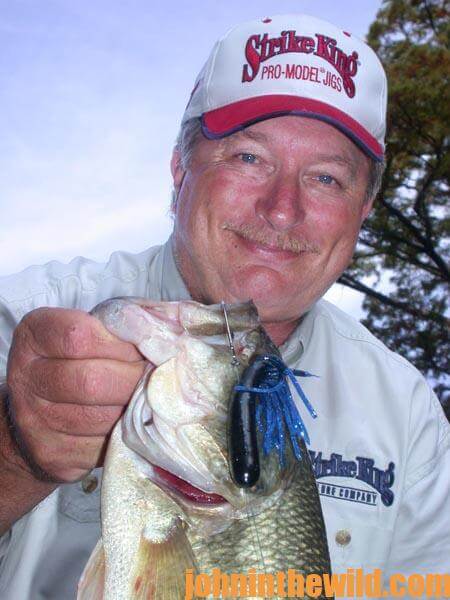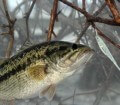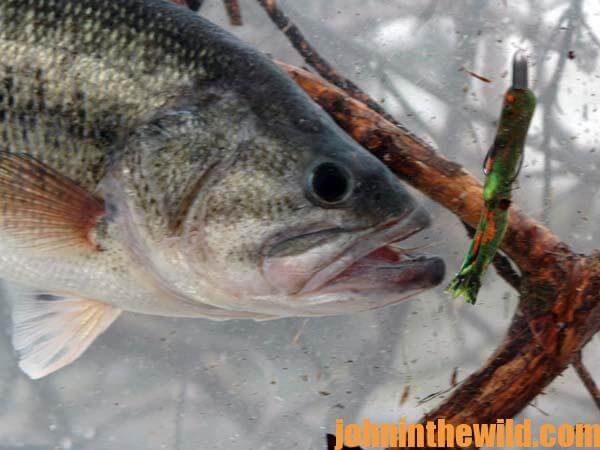John’s Note: Even beginners who never have fished before can catch bass on soft plastics. Tournament bass fishermen who strike out will bet the farm on their abilities to get bites on soft- plastic baits. In weather too hot or too cold or water too deep or too shallow for fishing other lures, you can bet on having bass fishing success with soft plastics. Let’s take a look at some of the phenomenal features of soft-plastic lures, America’s best bass baits.
Retired professional angler Denny Brauer, formerly of Camdenton, Missouri, and now living in Del Rio, Texas, and a member of bass-fishing’s Millionaire Club, has built his reputation and his fishing career primarily on flipping and pitching jigs and fishing spinner baits. However, in the 1998 Bassmasters Classic, Brauer fished a soft-plastic tube bait to win the Classic.
“I found the bass holding in 1-1/2- to 2-foot-deep water on a very shallow main-river flat,” Brauer recalls.
 “I needed a lure that would enter the water quietly, get the bass’s attention and make them strike. Even though the sun was high, the weather was hot, and the bass should have been holding in deep water, I discovered that the soft-plastic tube jig made by Strike King was the most-effective tool I could use to get those bass to bite. For some reason, these bass were holding in extremely-shallow water. I’ve learned that when fish hold on shallow-water cover, and you need a lure that can enter the water without making a lot of noise, often flipping a soft plastic tube jig, and stopping the bait just before it lands, so that it quietly enters the water can and will trigger strikes that you won’t get with louder, heavier baits.”
“I needed a lure that would enter the water quietly, get the bass’s attention and make them strike. Even though the sun was high, the weather was hot, and the bass should have been holding in deep water, I discovered that the soft-plastic tube jig made by Strike King was the most-effective tool I could use to get those bass to bite. For some reason, these bass were holding in extremely-shallow water. I’ve learned that when fish hold on shallow-water cover, and you need a lure that can enter the water without making a lot of noise, often flipping a soft plastic tube jig, and stopping the bait just before it lands, so that it quietly enters the water can and will trigger strikes that you won’t get with louder, heavier baits.”
Woo Daves Fishes the 6-inch Plastic Worm for Bass When the Water’s Rising:
Woo Daves of Spring Grove, Virginia, won the 2000 Bassmasters Classic on a 6-inch plastic worm at Lake Michigan in Chicago, Illinois. He prefers to fish a soft-plastic swimming worm. “The swimming worm tactic is one of the deadliest springtime tactics I know of, especially when the water’s rising. I fish the swimming worm over grass or any other water vegetation. I like the bright colors, because I believe the bass can see them better. I rig the plastic worm Texas style, cast it near the bank and swim it out to deep water.
“When water begins to rise, the bass will face the bank, looking for their food sources to come from the bank and move toward deep water. Swimming the worm on the surface of the water makes a natural presentation to the fish. Although this extremely-deadly tactic solicits strikes, many bass fishermen miss the fish that attack their lures. To catch a bass with a swimming-worm technique, you have to reverse your hook-setting procedure. A bass blowing up on a soft-plastic lure on the surface may make such a vicious strike that the fish may blow the bait out of the water without taking it. Then, if you set the hook when the fish strikes, you’ll usually miss the bass. To consistently catch bass using the swimming-worm method, fight the urge to set the hook when the bass blows up on the bait. Instead, wait until after the strike when you see your line moving sideways to set the hook. Then you’ll catch more bass.”
 To learn more about bass fishing, get John E. Phillips’ Kindle eBooks and some print books, “How to Bass Fish Like a Pro,” “How to Win a Bass Tournament,” “Catch the Most and Biggest Bass in Any Lake: 18 Pro Fishermen’s Best Tactics, “Hot Weather Bass Tactics” and “How to Become A Tournament Bass Fisherman.” Click here to get these books.
To learn more about bass fishing, get John E. Phillips’ Kindle eBooks and some print books, “How to Bass Fish Like a Pro,” “How to Win a Bass Tournament,” “Catch the Most and Biggest Bass in Any Lake: 18 Pro Fishermen’s Best Tactics, “Hot Weather Bass Tactics” and “How to Become A Tournament Bass Fisherman.” Click here to get these books.










